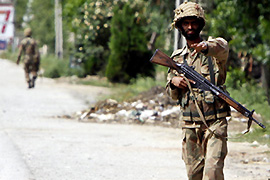Pakistanis flee Swat fighting
More troops sent to battle Taliban as concerns grow over civilians caught in conflict.

Government estimates suggest that 200,000 people have already fled. UNHCR officials said another 300,000 people were on the move or about to flee.
The latest exodus brings the number of people displaced in the region by sustained violence over the last few months to a million, UNHCR officials said.
Desperate civilians
The Pakistani military has killed 143 suspected opposition fighters over the past 24 hours in Swat, a military spokesman said on Friday.
| In video |
|
|
“Approximately 143 militants have been reported killed in Swat valley,” Major-General Atthar Abbas said. There was no independent confirmation of the death toll.
Additional government troops were sent to the Swat valley on Friday, a day after its prime minister ordered the army to eliminate the Taliban battling government forces for control of the key North Western Frontier Province (NWFP).
Swat is a part of the Malakand division of the NWFP.
In a televised address on Thursday, Yousef Raza Gilani, the prime minister, called for unity against “extremists” he said were threatening the nation’s sovereignty and who had violated the deal.
“The armed forces have been called in to eliminate the militants and terrorists,” he said.
Al Jazeera’s Kamal Hyder, reporting from Peshawar, the capital of NWFP, said civilians in the region affected by the fighting were in a desperate situation.
“Hundreds of thousands of people are stranded along the highway between Mingora and Malakani,” he said.
“The biggest concern as we spoke to the ICRC [International Committee of the Red Cross] this morning is the number of people moving.
| In depth |
|
|
“They said they were trying to help in whichever way they could … Many people who are stuck inside Swat are asking the government why there was no plan; why they were not given adequate warning to get out and save their souls.”
“Whatever happens [in Swat] will decide the future of the military itself because they are pitted against what is considered to be a guerrilla force which is moving rapidly.”
Sebastian Brack, a spokesman for ICRC in Pakistan, told Al Jazeera that their immediate concern was access to the victims of the fighting.
“A large number of people stuck in areas where fighting is taking place cannot escape,” he said.
“We are preparing ourselves to be able to act as soon as the situation allows – hopefully by the end of next week – to be able to bring in help: emergency food, shelter, blankets and also medical care.”
Mass exodus
On a visit to the United States, Asif Ali Zardari, Pakistan’s president, said military operations would last until “normalcy” returns.
“It is going to carry on until life in Swat comes back to normalcy,” he said after meeting influential US senators.
 |
| Pakistan’s PM has said the offensive will last until “normalcy” is restored [AFP] |
Al Jazeera’s Sohail Rahman, reporting from Pakistan, said: “[There has been] a lot of pressure on the government that they have acted a bit too late in giving the army the greeen light.
“I think the army have been looking for official civilian backing for their action and the public perception would be that they would not be blamed for attacking the Taliban. It was a civilian decision made by the civilian government.”
The latest bout of fighting has all but extinguished the peace deal between the government and the Taliban.
Rahman said: “The military operation continues and it is going to continue for sometime. These are not easy areas [where fighting is taking place].
“It is not a conventional war. It is very much a guerrilla war from the Taliban side, and therefore the military don’t have specific targets to go for and that is why helicopter gunships are the main tool that the military are using.
“[But] they [the military] can only use them when the weather is good, and last weekend we saw very bad weather and a halt to those operations. They resumed again on Monday and Tuesday.”
Gilani’s accusation
In his address on Thursday, Gilani accused the Taliban of threatening Pakistan’s sovereignty and violating the peace deal.
That agreement, brokered by a local religious leader, sought to put three million Pakistanis in a wide region of the NWFP under sharia law, in exchange for the Taliban agreeing to end a nearly two-year uprising.
“In order to restore honour and dignity of our homeland, and to protect people, the armed forces have been called to eliminate the militants and terrorists,” Gilani said.
“The time has come when the entire nation should stand side by side with the government and the armed forces against those who want to make the entire country hostage and darken our future at gunpoint.”
The Pakistani military says it has killed more than 80 fighters in recent heavy fighting in Swat, Buner and Lower Dir, all part of Malakand.
The army launched its major offensive on Wednesday, with reports of aerial support being used overnight into Thursday.
Talat Masood, a retired general who worked in Pakistan’s defence ministry, told Al Jazeera that Pakistan was “probably paying a price for the wrong policies it has pursued”.
He said that if action had been taken much earlier – months before or even during former president Pervez Musharraf’s time, the “state of affairs that we find today would not have happened”.
“And these militant forces, they would not have been of much strength,” he said.

 Swat fighting threatens Pakistan army unity
Swat fighting threatens Pakistan army unity